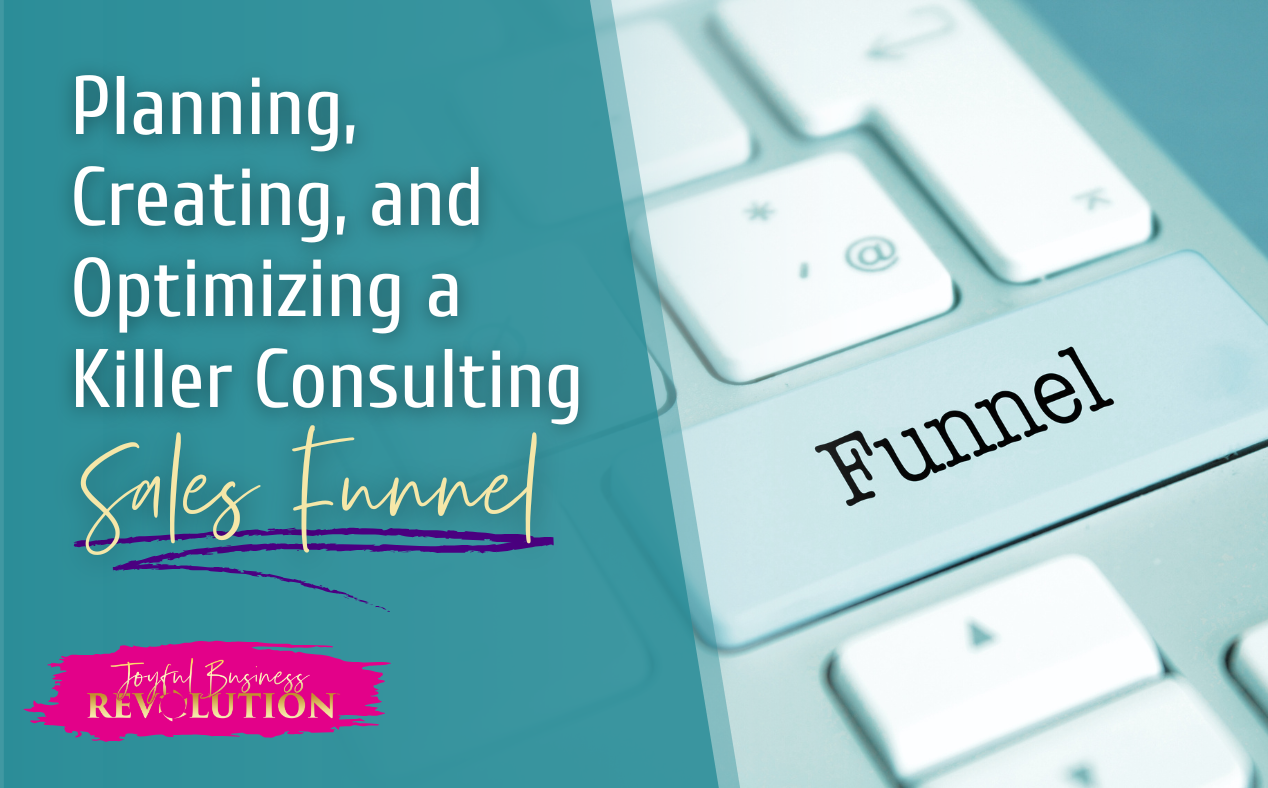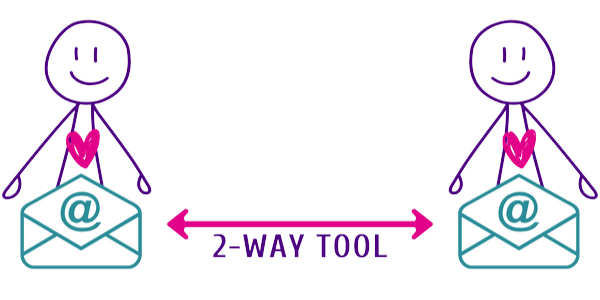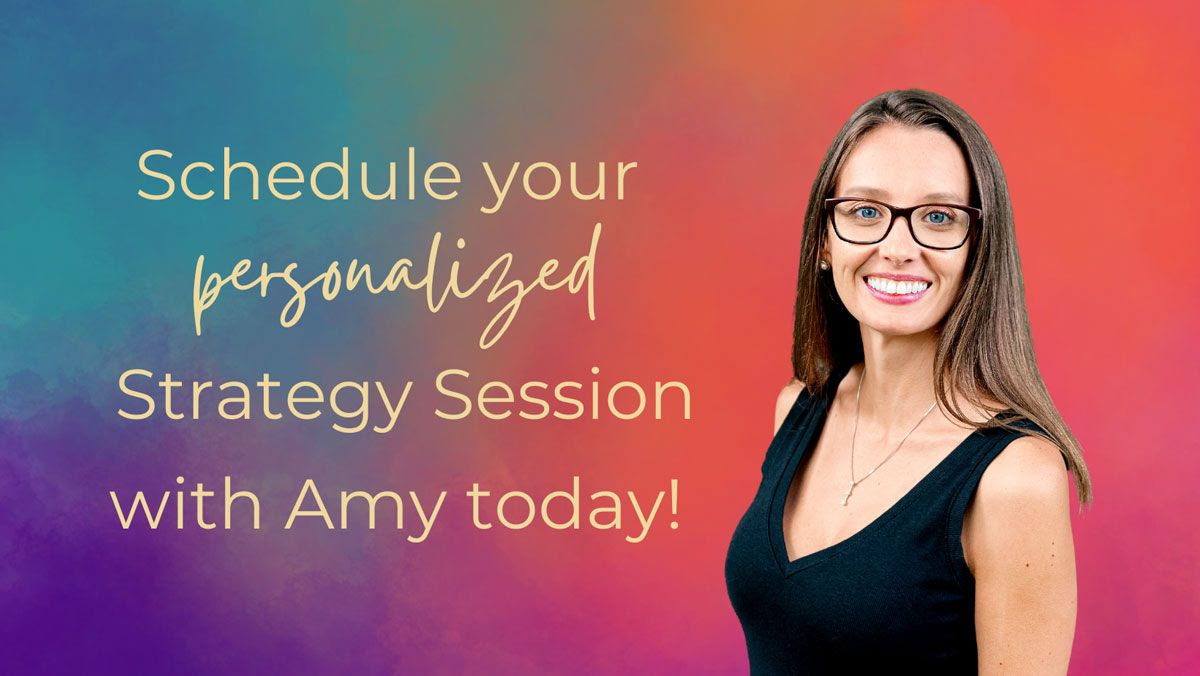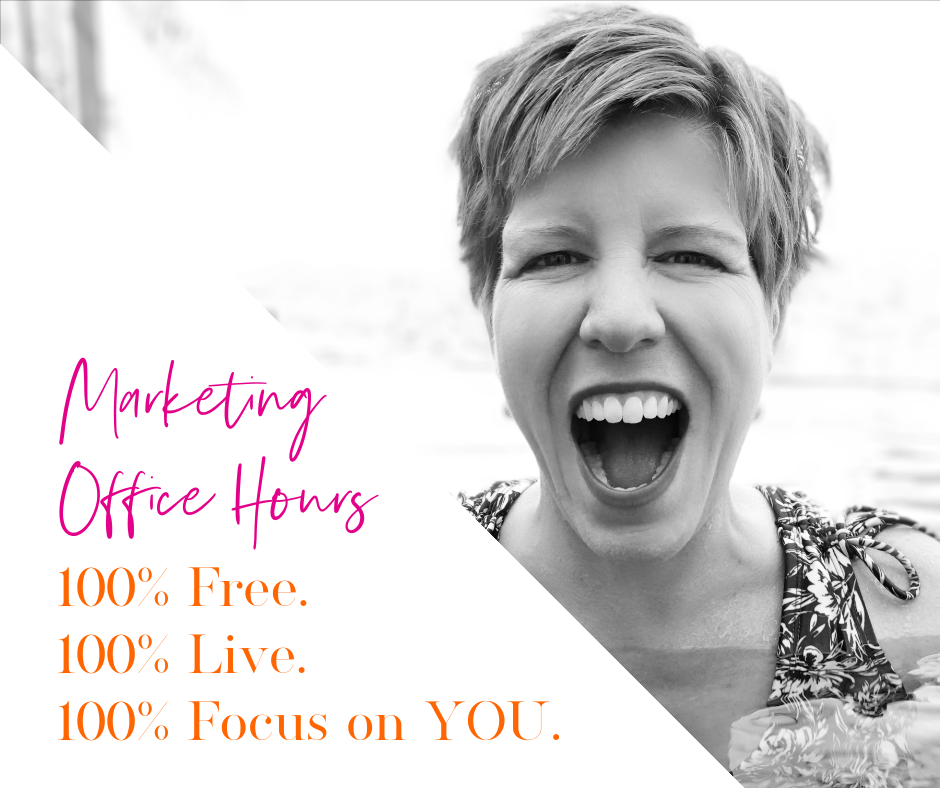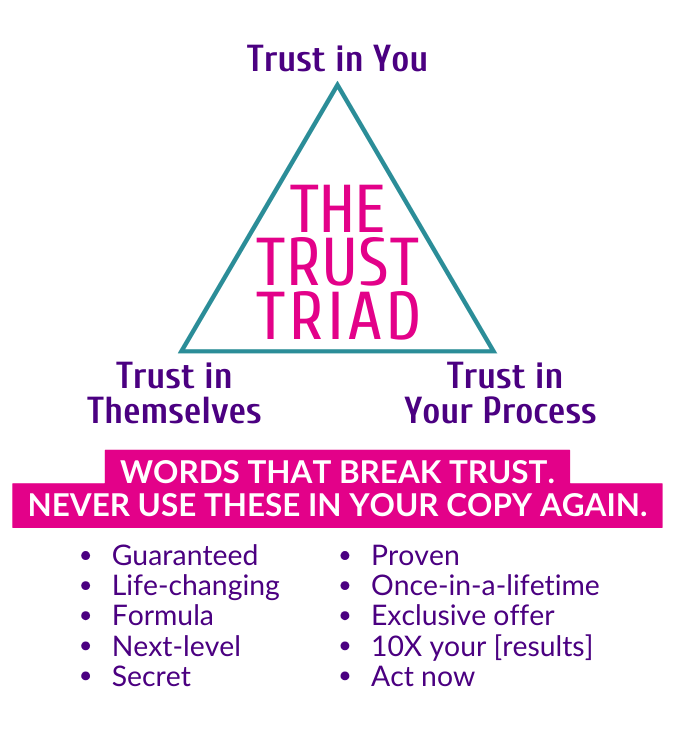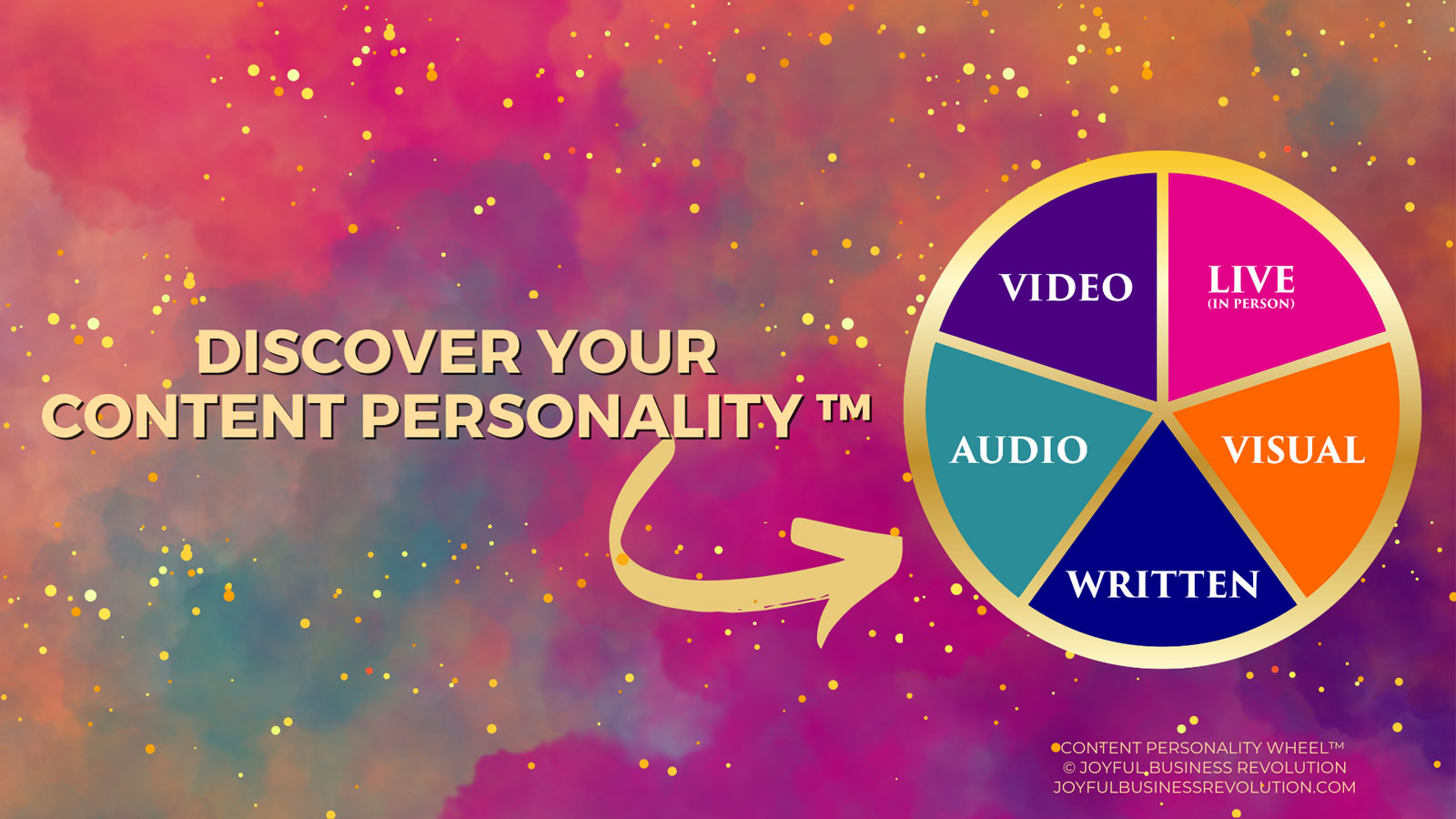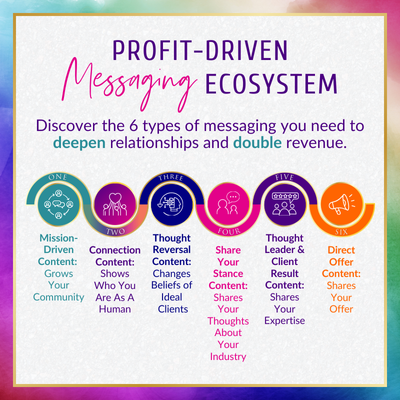Most consultants and coaches pour their heart and soul into creating a sales funnel designed to speed up relationship building and build sales. This is fantastic — I firmly believe that the more of “you” there is in your funnel, the more authentic the whole process will be, and the more sales.
The only problem?
While having anything in place is better than having nothing, the unfortunate truth is that most consulting sales funnels don’t work. Or at least, they don’t work as well as people want them to.
Over the last decade of consulting with small business owners on their funnels, I’ve pinpointed three main reasons most sales strategies feel broken right out of the gate:
- Most sales funnels are built on outdated or untrue assumptions. Because they’re designed to push instead of connect, they prioritize selling over growing relationships. And since people buy based on trust, especially when it comes to choosing a consultant, “pushy” funnels usually fail.
- The sales funnel structure is all wrong. It’s far too linear when most people’s journeys are anything but. In fact, I’m not a big fan of the word “funnel.” It’s too narrow. More on that below.
- The messaging needs some help. Even when your copy is *chef’s kiss* amazing, it falls flat if it doesn’t resonate with your perfect-fit potential clients
So if you’ve been wondering why your consulting funnel isn’t working, keep reading.
I’m going to show you the exact strategies I use to help small businesses create a customer journey that speaks to potential customers and nurtures relationships with loyal clients.
What are sales funnels?
Sales funnels are structured journeys that guide your audience from the first time they raise their hand to connect with your brand until they become a paying client.
That’s the simple definition.
But in my experience, it’s not entirely accurate. Here’s why:
First, it’s a cold, clinical definition that doesn’t account for the fact that you’re marketing to humans.
Whether you’re a consultant for mid-size or enterprise-level companies or solopreneurs, the people you’re buying from are human. So you have to connect with them on a human level. Instead of pushing prospects through a narrow journey, your consulting sales funnel should prioritize building a two-way relationship.
Second, the word “funnel” is problematic.
I mentioned above that I don’t like it because it makes assumptions that everyone will start at the top of the funnel and go all the way through. It also assumes that everyone is starting at one point and growing at the same pace and wants to sift through all your content.
I wish everyone realized that your most-ready buyers don’t want to do that. They don’t have the time or energy.
Instead, they’re ready to take action now and need a more direct option. They want to get a resource or training and immediately get the answer to “How do I buy?”
HubSpot addresses these challenges with its Flywheel and Lifecycle approaches. Perhaps predictably, I have another take.
Instead of the term “sales funnel,” I prefer sales pipeline or sales field.
What is a sales pipeline?
A sales pipeline, like a sales funnel, is a structured journey that leads potential buyers from prospect to client. However, where the word funnel implies an ever-narrowing consistent stream, “pipeline” is more flexible and meets buyers where they are.
Many people — especially in B2B marketing and sales — use terms like Skeptics, Prospects, Marketing Qualified, and Sales Qualified to talk about their sales pipeline. My definition is a little different.
The best analogy I have is the pipes that run through your house carrying water to different rooms. For example, you turn on the water in a bathroom when you wash your hands and turn it off when you’re done. Then you might go to the kitchen and turn your water on to fill up the coffee pot and turn it off when you’re done.
Those different rooms and ideas are metaphors for your different offers that meet your prospective clients’ individual — and differing needs. When you can recognize this, you can “replumb” your customer journey to be flexible based on where your audience comes in.
What is a sales field?
You may have seen me talking about how I’ve reorganized Joyful Business Revolution around the seasons. Loosely, the idea is that we’ve stopped talking about things in terms of Q1, Q2, Q3, Q4. Instead of quarters, we’re thinking of things in terms of the seasons:
- Winter — resting and expanding your vision (think strategic planning)
- Spring — planting seeds and new beginnings (think lead generation)
- Summer — enjoying the long days and beginning to reap the harvest (think offer launch, sales, and growth)
- Fall — reaping what you’ve sown with a harvest and gratitude (think sales, results, operations, and celebration)
When you think of your sales funnel in similar terms, it becomes a field — not all crops grow at the same time. Everything needs to be planted, tended, and harvested at different times of the year.
What’s more, each type of plant needs different varieties and nutrients.
Taking a one-size-fits-all approach is neither realistic nor effective.
By rotating offers (putting crops in different fields) and ensuring that there’s a plan in place to plant and nurture seedlings at the best times for each plant, you can, again, provide a flexible customer journey based on what each person in your audience needs right now.
Why use the term “sales funnel?”
This is important. I’ve just told you that I’m not a fan of the term sales funnel, especially when it comes to converting consulting clients.
The reason is simple. When I use the phrase “sales funnel,” people typically know what I’m talking about. And it’s the term that most people use to talk about the path to nurturing customers. No additional explanation is needed.
Then, when people hire my team to come in and consult on their funnel or messaging, we can help find the structure that’s best for their business and clients.
Worried your sales funnel isn’t working? We can help. Set up a call with Amy and she can walk you through the different options.
The 4 Consulting Sales Funnel Stages
Above, I shared that most people think about the buyer journey in traditional marketing terms: Skeptics, Prospects, Marketing Qualified, and Sales Qualified.
Sure, you could shoehorn most consulting clients into these phases if you really wanted. But this is one of those “just because you can doesn’t mean you should” situations.
I’ve found that “traditional marketing terms” don’t actually reflect the relationships most of my clients want to build (and grow!) with their clients.
Instead, a well-designed relationship-driven sales funnel is personable, human, and moves the right people along a journey they have control of.
That means, at every single phase — especially when we’re talking about email marketing — your consulting sales funnel should give prospects the opportunity to:
- Unsubscribe
- Respond to a human
- Get additional resources
And I want you to think about email marketing — it’s the one constant you have in this world where every social media platform is going crazy (read: unreliable).
There’s just one challenge:
When I serve as a fractional CMO, and consult on sales funnels, the #1 problem that I encounter is an unmitigated email disaster.
I find that businesses are taking the time to grow their lists, but they half-ass the implementation:
- They don’t tag people as they come in. And I mean no tagging at all, not based on actions, not how they joined the list, not the way they answer intake or survey questions — none of it is tagged.
- There’s no journey. They often have an email sequence, but there’s nothing that takes into consideration where their audience is now and what they want. Or if there is, it’s not well-executed.
However, when I come in, I focus on the stages below to help consultants sort out and clean up emails so they start making money.
I mentioned 4 stages above, but there are really 5.
The first just happens behind the scenes, so while I’m touching on it here as Stage 0, know that it’s not actually a stage of the customer-facing sales funnel.
Stage 0: Planning and Messaging
Before you create or reimagine your sales funnel, I want you to review your offer and your audience. Doing so ensures that you:
- Understand your perfect-fit clients, where they are now, and what they want
- Position your offer effectively with the right messaging
- Can connect with the right audience and nurture those relationships
Without the right planning and messaging, your sales sequence will fall flat.
Note: Stages 1 to 4 are what happens once you’ve done Stage 0 effectively and people have raised their hands to join your funnel. From here, I’m assuming that they’ve given you permission to email them.
Stage 1: Welcome + Delivery
Most sales funnels for consultants are driven by a lead magnet of some kind:
- A downloadable PDF
- A free or low-cost digital product
- A free intro lesson to a course
- A free or low-cost workshop, training, or webinar
- A quiz
It makes sense then that the very first thing you do is give them what you’ve promised. So, the first step in your sales funnel had better be about telling them how to access the thing and how to get value out of it.
At this point, I usually recommend a short welcome into your community and an intro to you since these emails are the most opened and most clicked.
Stage 2: Getting to Know You
The next step is about bringing your prospective clients into your world. I always recommend:
- Acquainting them with your ecosystem and values.
- Showing them who you are, who you work with, and how you help.
- Teaching them your lingo and the terms they’ll likely encounter with your brand. For example, we have a glossary of terms.
- Encouraging engagement. We always ask for a reply which has an added bonus of improving email deliverability.
- Invite them to connect. Maybe that’s getting to know you. For example, we offer free 20-minute calls, and have lots of free and low-cost events where people can get to know us.
Stage 3: Choose Your Own Adventure
Remember those adventure books? As you read, you’d pick an outcome and get directed to a different page. When you set up your consulting sales funnel as a pipeline or a field, you open up a new world to people who are in your funnel.
As they go through the funnel (aka pipeline), you can help them choose their own adventure based on the outcomes they want. This interactive approach is typically education-driven with a blend of resources based on what they need.
People experiencing each “adventure” might get similar content, but the way you position it changes based on what they want. If you’re picturing a rats nest of potential journeys and your eyes are getting wide, don’t let this stress you out.
The process of creating a “Choose Your Own Adventure Funnel” can be incredibly simple as long as your messaging is targeted and pointed.
We’ve created a Choose Your Own Adventure Funnel in our business and would be happy to show you how to do it for yours. Want to learn how? Join our next marketing office hours and bring it up as a question!
Stage 4: Connect.
People deserve an opportunity to talk to someone before they purchase your program, whether through email or Zoom.
This is something I firmly believe with my whole soul. In fact, it doesn’t matter if they’re looking at a low-cost offer or something high-ticket. They deserve to connect with you or someone on your team. That’s why it’s part of every email we send out.
Stage Infinity: Surprise and Delight
What happens if people don’t buy in the first four stages? Do you stop talking to them? I hope the answer is no. While your ongoing marketing efforts may be less frequent, you shouldn’t stop entirely. Instead, by providing new opportunities to grow, learn, and connect, you can stay top of mind for when they are ready to do something else with you.
And remember, not everyone in your funnel is a prospective buyer. There are also superfans who believe in you and will support you, as well as potential referral partners.
Is my sales funnel working? (and what to do when it’s not)
Most coaches and consultants who come to me for sales funnel help know in their soul when their funnel isn’t working. Occasionally, people’s funnels are working great and they just want better performance.
The question I pose is: Do your results match your effort and expectations?
If not, then it’s time to revisit your sales funnel and ensure:
- Your messaging speaks to your perfect-fit audience
- You’re using it as an ethical way to help people see their gaps
- You use clarity-driven content to make sure your audience understand where they are in the process and if you’re the right fit for them
- You’re building trust triads
Wondering what a trust triad is and how it plays into your consulting sales funnel?
The number one job of a funnel is to grow relationships with your audience. And the best way to do that is to establish trust in three areas:
- Trust in you, the consultant, as a human behind a computer.
- Trust in your process to help them go from where they are to where they want to be.
- Trust in themselves so when they’re ready to purchase, they’re doing so as a full YES instead of because of scarcity.
Anecdotally, 99% of business owners I talk to don’t know how to do this. However, a well-designed funnel puts the person into the driver’s seat of their experience, which goes back to the Choose Your Own Adventure approach.
Candidly, outside of funnel structure, the other major problem I see is messaging. Someone I know who does sales consulting recently post on social with a laundry list of symptoms as to why your sales aren’t converting on a sales call—almost all of them were messaging.
5 Things Making Your Sales Funnel Less Effective
When I’m providing sales funnel consulting, here are some of the things I watch for that turn people off.
-
- Hidden Pricing—even if your prices are custom, it’s a good idea to anchor them somehow. I’ve seen people use “starting at” or even providing budget ranges on a contact form.
- Unclear Audience—if your audience doesn’t know it’s for them, why would they buy?
- False Urgency—while it can work for the short term, it also erodes trust for the long term.
- Fear-Based Titles—if it’s not clear what they’re missing out on, your audience will leave before they even know what your offer is.
- Promising “Live” When it’s Prerecorded—I have no issue with directing people to a pre-recorded video as long as you’re not promoting it as live. Don’t promise a live training if you’re rebroadcasting a pre-recorded video. That’s slimy.
A few other things that drive me crazy and might leave your audience with a bad taste:
- Too many fonts
- Red and black colors
- Too many graphics
- Getting thrown into someone’s launch unsuspectingly.
The bottom line?
Your funnel should not make my mental health decline and should not fill my inbox with multiple messages over the course of a day or a week. And if you’re doing a “traditional” launch funnel, consider a shift to permission-based launching, letting people opt out of the launch without opting out of emails.
Better yet, consider inviting them to raise their hand before the launch even starts and opting into those emails.
Different Types of Consulting Sales Funnels
It doesn’t matter if you use automated funnel software like Russell Brunson’s Clickfunnels or another email marketing program that’s suited for solopreneurs. The sophistication of your funnel determines the sophistication of your buyer.
Here are several different types of funnels consultants use:
Launch Funnels
While I talked about this above from a permission-based focus, let’s go into more detail here. Launch funnels often start with some kind of an event, but not necessarily. They typically have a window open to people on the waitlist and a 7-10 day launch, with emails every day.
Personally, I’m not a fan of these, they’re exhausting and can make people feel less positively about your brand. In fact, from what I’m hearing, these “traditional” launch funnels may be on their way out, especially for coaches and consultants with small audiences.
I don’t think they’ll ever go away entirely, especially for live cohorts, and businesses with large audiences, but there may be other (better?) options for you if they’re not your cup of tea.
Lead Magnet Funnels
Just about every consultant or coach I talk to who prioritizes email marketing uses a lead magnet funnel, and for good reason. They’re relatively easy to create, low-pressure, and focus on delivering value up front. As a former teacher, educating is what I love most and many coaches and consultants are in it to help our people!
I talked a bit about lead magnets above when I discussed the stages of a consulting sales funnel. Your goal in creating a lead magnet is to trade it for your prospect’s email address, and it could be anything.
The only caveat is you’ve got to make it relevant to your audience AND to the offer or journey you’re leading them towards.
Quiz Funnels
Quizzes are one of my favorite lead magnets and funnels. They’re engaging and interactive by nature, with results that are tailored to how your audience responds to each question. The best quiz funnels seamlessly connect the topic and results to an offer.
We use a quiz funnel to help our audience learn more about our business. The Content Personality® Quiz is designed to help you figure out your natural content creation strengths. Since content is a common place for people to get stuck, we identified 5 types and created a roadmap for each.
Want to get our guide to your content personality? Take the quiz!
And spoiler alert — it might not be what you think. As a writer, I thought I’d have a written Content Personality®. However, I show up best live and in-person, which leads me to the next type of funnel.
Live, In-Person Event Funnels
I often say that email is my love language. However, live, in-person events are my Content Personality®. They’re how I show up best and thrive. For me, there’s nothing better than connecting in person.
That’s why I host several in-person events each year. What’s more, I use email marketing to fill every seat. I’ve written extensively on this, including listing the exact process I use and specific emails I send. Instead of reinventing the wheel, I’ll send you over to that blog post to learn my live event marketing funnel strategies.
Online Event Funnels
Many people talk about online events in the same breath as live in-person events. While there are several similarities between them, they’re quite different. That said, I advocate for making them as close to an in-person experience as possible to make your webinars and online classes unforgettable (and to turn them into high-converting sales funnel opportunities).
The biggest difference between an online event funnel and an in-person event funnel lies in the timeline. People don’t need nearly as much notice for an online event, so the marketing and funnel can be accelerated. Instead of taking place over months, these funnels are usually only a few weeks.
Again, I’ve written extensively on this, so will direct you to my blog post sharing the tips, tricks, and sequences I recommend for online event funnels.
Referral Funnels
Referral funnels are one of my favorites because they require so little effort and can result in the best leads and relationships ever.
Let me ask you two questions that the answer should be an unequivocal yes to:
- Are you more likely to purchase from someone who you know and trust?
- Are you more likely to purchase based on a recommendation from someone you know and trust?
If someone people already trust also trusts and recommends you, you can fast-track the Trust Triad.
So how do you build a referral funnel as a consultant? Easy. There are three steps:
- Talk to people — colleagues, referral partners in ancillary industries, and past clients.
- Exchange information on who would be a good referral.
- Check in regularly.
Sure, you could provide them with email templates or referral links. You could even create a formal referral or affiliate program. Or, you could go hyper-simple.
The middle ground is creating a spreadsheet to keep track of who these folks are and following up with them from time to time. It costs you very little. At worst, you have some great friendships. And at best, you have a thriving referral-driven business.
I know several consultants and coaches who have built their entire business through referral sales funnels and are perfectly happy continuing with this method.
Follow-Up Funnels
Don’t make the mistake of ignoring your sales follow-ups. Outside of messaging and funnel structure, it’s probably the top sales funnel error consultants make. Now, of course, you don’t want to show up in people’s inboxes daily (or worse yet, hourly).
However, if people don’t respond to your proposal or the first message after a sales call, don’t let those leads die on the vine. People are busy and have a lot going on outside of your interaction with them.
Unless your gut tells you otherwise, always assume the right intention, and have a plan for following up. I don’t recommend setting this up as a formal funnel programmed into your Clickfunnels, Ontraport, or Dubsado. The only exception is a quick follow-up email if they don’t sign the proposal right away.
Otherwise, this requires a more delicate touch based on specific resources or testimonials that might help them make a decision. Instead of full-fledged marketing automations, create a few email templates and automate reminders to personalize them.
Always Open Funnels
Saving the best for last! At Joyful Business Revolution, we’ve chosen an always-open consulting sales funnel, which is so much less stressful than Launch Funnels. The only time there’s urgency is when we actually have an offer with a specific deadline and/or limited seats.
Choosing always open gives us the flexibility to practice conversion rate optimization (CRO), or more simply, to always be iterating based on what’s happening in the world, with our market, or with our offers.
Best of all, it allows us to stay away from bro marketing techniques and focus on what actually matters to our clients and their audiences.
Creating Your Consultant Sales Funnel
What I hope you take away from this is that, despite what many sales funnel consultants may say, there’s no single best way to create your funnel.
There’s no single best email marketing platform, no best place to host your sales pages, and no best digital marketing techniques.
In fact, the only real rules that I teach are that your marketing be ethical, transparent, and permission-based. Otherwise, all that matters is which techniques and approaches work for your business and your audience.
My team and I would love to help you figure out what’s going on with your sales funnel and how to make it work to make you money. Just schedule a 20-minute consult here, and we can take it from there!

